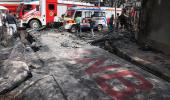'Loss of thrust in both engines would have left the crew with minimal options for recovery.'

There is no official verification about the cause of the crash of AI 171, however, a bird strike or a technical failure in the engines could be among the possible causes
"The aircraft possibly suffered one bird hit just before or immediately after the lift off. After the first bird strike to one engine, the aircraft would likely have continued its climb on the remaining engine."
"However, a subsequent bird strike to the second engine -- or an unrelated second engine failure -- at that altitude could have led to a total loss of thrust, leaving the crew with minimal options for recovery," says a retired IAF and Air India pilot with 45 years of flying experience.

Video footage of AI 171 moments before impact shows the aircraft in steady descent, with no significant instability.
This behaviour suggests that while the aircraft had likely lost engine thrust, it remained in control.
Such a flight profile is consistent with a dual engine failure, where the pilots are attempting to glide the aircraft to land but are ultimately unsuccessful due to altitude, terrain, or other constraints.
"The reason for the descent could be loss of power in the engines. Since the aircraft did not climb up, one can deduce that there was no power in the engines," he says.
"From the countdown timer of CCTV footage shown on TV, it appears that the aircraft started descent 15 seconds after lift-off.
"If the time between lift off and commencement of descent is say 15 seconds then the gear being left down would not be surprising. Since the pilots would still be in the process of controlling the flight path."

In case of a bird hit, pilots follow established procedure. The aircraft can continue the climb on one engine with no change in configuration till about 400 feet. The pilot can then take remedial measures for a return to the departure airport or the nearest airport.
Aircraft can take off safely even if one engine fails. Power loss on take-offis one of the most practiced exercises in aviation.
A dual engine failure on take-off is extremely rare -- but much more critical. At low altitude, there is very little time or room for recovery.

The key to understanding the reason for the crash will be known through the cockpit voice recorder and flight data recorder, commonly called the Black Box.
"Gear retraction is one of the first steps after take-off. The gear being down in this case is not normal and there could be many explanations for it -- like the aircraft either suffered an engine failure at or shortly after take-off or never achieved a stable climb."
"In a normal engine failure with no windshear, the gear is retracted once a positive rate of climb is confirmed."
[Windshear is a sudden change in wind speed or direction. It can happen at any altitude but is dangerous during takeoff and landing.]
In case of windshear, the gear is left until clear of the shear, even if an engine fails in order to prioritise control and energy over drag reduction.
"The continued descent without gear retraction strongly supports the possibility of a dual engine failure or a loss of thrust severe enough to cause a crash."

Modern commercial aircraft undergo rigorous preflight checks carried out by engineers who perform technical inspections, run built-in diagnostic systems, and certify the aircraft as airworthy.
Pilots conduct their own checks, including external walkarounds and detailed cockpit procedures, checking everything from flight controls to engine parameters.
"Aircraft systems are designed to alert pilots to any faults prior to take-off. Given these safeguards, any in-flight failure is most likely due to a sudden event -- such as a bird strike or a technical malfunction," says the Air India pilot, speaking on condition of anonymity.
The aircraft would be carrying more than 50 tonnes of fuel and has disintegrated into flames. Only one passenger survived.
"People have survived in amazing situations. Miracles happen."










